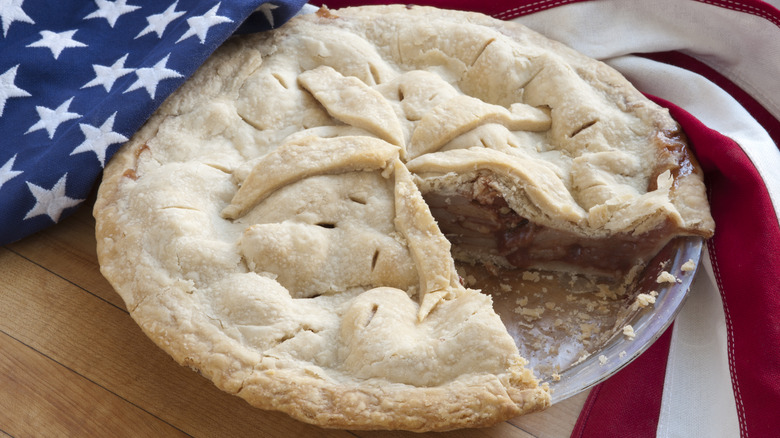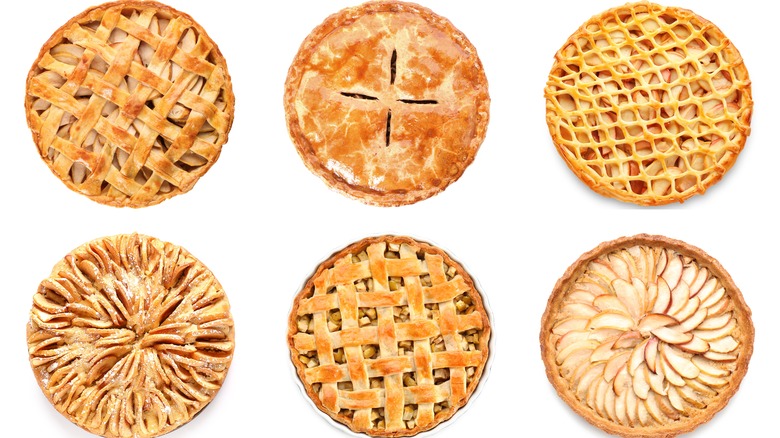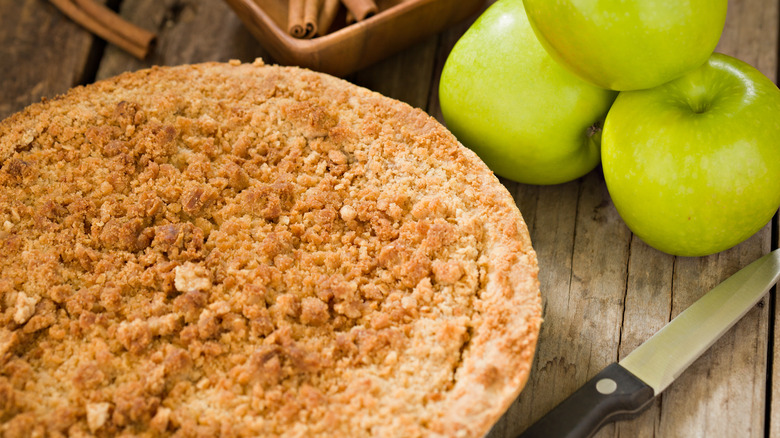Why We Think Of Apple Pie As American, Even Though It's Not
Apple pie is a delicious symbol of the American dream and the patriotic feelings that come with it. But, the first apple pies were made in 14th century England, and the English and other Europeans enjoyed them for centuries before anyone ever made them on American soil. So then, why do Americans serve apple pies at Independence Day cookouts rather than truly American pies like pecan pie or Boston cream pie? It's about what the apple pie represents rather than its origin.
By the 1600s, international trade brought apple trees to the colonies, and it was common for colonial farmers to raise orchards. In the early 1800s, John Chapman began to create apple nurseries across the East Coast, planting the seeds for the myth of Johnny Appleseed to take hold of the nation. By the 1870s, stories about Appleseed popped up, painting him as a kind and earnest character who spread apples through the United States with grit and tenacity. Easier access to local apples and feelings of national pride made apple pie a staple in America.
In a patriotic letter to the New York Times in 1902, one reader wrote, "Pie is the American synonym of prosperity... pie is the food of the heroic." During World War II, the pie was used as a symbol to motivate soldiers to embrace American patriotism. Around this time, the phrase "as American as apple pie" gained popularity, and the apple pie has remained a symbol of American freedom ever since.
The European origins of apple pie
One of the earliest recorded English recipes for fruit pie containing apples comes from the 14th century. But people likely made fruit pies for years before this, with recipes being orally maintained rather than written. Early English apple pies did not look or taste like the ones we know today. One of the first English apple pie recipes, for example, calls for apples, raisins, pears, figs, saffron, and spices, but does not call for any sugar. The crust was also more similar to a container than a part of the pie. The English served these early fruit pies in a coffin crust — a tough, almost inedible dough or crust used to cook the contents rather than be eaten.
Pie recipes eventually evolved to include sweeteners like sugar, with the first American cookbook from 1796, "American Cookery," calling for sugar and rose water. The crust, as well, evolved, with Dutch bakers developing the use of a sweeter, edible crust that more resembles a modern pie crust.
Apple pies in America
The United States, referred to as the Great American Melting Pot, incorporates cultural influences from nations across the world. Apple pie, too, can be seen as a melding of various cultures. The apple, an Asian fruit; the filling, an English delicacy; and the crust, a Dutch innovation in culinary expertise, all came together to make something wholly American.
Americans began to raise never-before-seen types of apples in the 18th century. By 1800, there were over 14,000 varieties of apple growing in the United States (per Smithsonian Magazine). Advanced interest in cross-pollination of apples led to broader availability of sweet apples like Red Delicious and Jonathan apples and semi-sweet apples like the Northern Spy, which are still used in pie recipes today. People also began to use other North American fruits – like black cherries or fresh cranberries in apple pie filling.
Apple pies in modern stores and bakeries also borrow from various cultures. You might see variations like the Dutch and Swedish apple pie. Some Dutch apple pies in America are a take on the appeltaart, a traditional baked good in the Netherlands with a dense, cakey shortcrust and a sweet apple filling. However, other "Dutch" apple pies feature a crumble or streusel topping, which some believe was popularized in the American colonies by French and German immigrants, not the Dutch. And the easy Swedish apple pie is a take on smulpaj, a Swedish dessert featuring sweetened fruit filling topped with an oat crumble crust.



